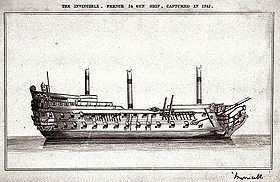Name Invincible Name HMS Invincible Construction started May 1741 Tons burthen 1.627 million kg | Laid down May 1741 Acquired 3 May 1747 Launched 21 October 1744 Builder Rochefort | |
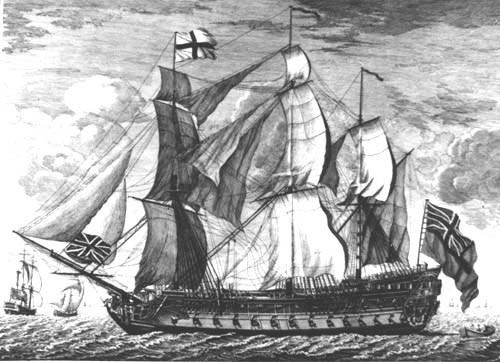 | ||
Captured 3 May 1747, by Royal Navy Notes Participated in
First Battle of Cape Finisterre | ||
The Invincible was a 74-gun French ship of the line, later a third-rate of the Royal Navy.
During the early part of the 18th century British ship designers had made few significant advances in design, whereas French shipbuilding benefited from a remarkably creative period. At the time of the capture of Invincible, there was not one 74-gun ship in the Royal Navy. By 1805 at the battle of Trafalgar, three quarters of British ships of the line were of this singular design and the 74-gun ship had become the backbone of all major navies of the world.

Invincible was one of the first trio of a new and longer type of 74-gun ships. Until 1738, French 74s had been little more than 154 (French) feet in gundeck length, carrying just thirteen pairs of 36-pdr guns on the lower deck, fourteen pairs of 18-pdr guns on the upper deck and eight pairs of 8-pdr guns on the quarterdeck and forecastle, with the balance of the 74 guns made up of four small 4-pdr guns on the poop.
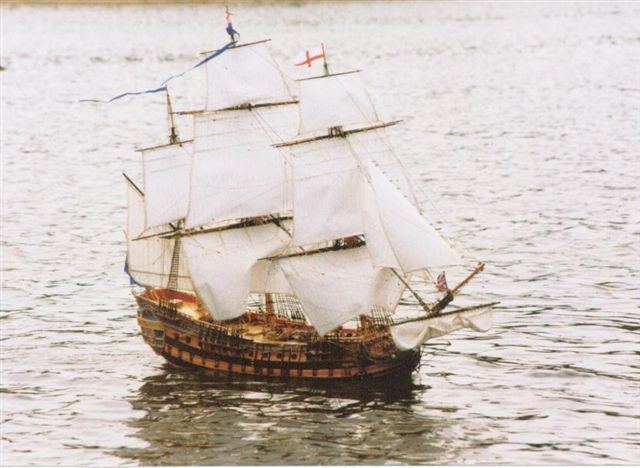
This was changed by François Coulomb's design for the Terrible, launched in 1739 at Toulon. The gundeck length was stretched to 164 (French) feet, and the four small guns on the poop were eliminated, replaced by new gunports for an additional pair of 36-pdr guns on the lower deck and an extra pair of 18-pdr guns on the upper deck. This new gun establishment became the standard for all subsequent French 74s. The next two ships, Invincible designed by Pierre Morineau and Le Magnanime designed by Blaise Geslain, were begun in early 1741 at Toulon and were each even longer than Le Terrible.
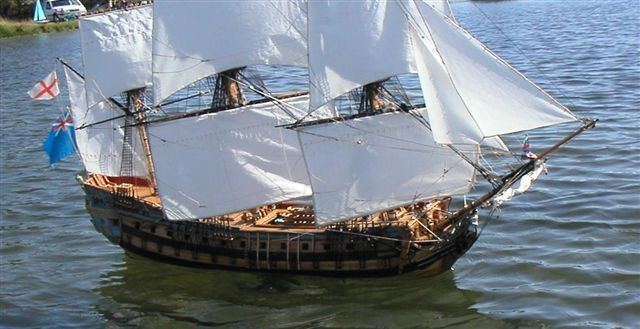
At the First Battle of Cape Finisterre (14 May 1747) during the War of the Austrian Succession, Invincible was escorting a convoy of merchant ships when she was sighted by the British channel fleet of 16 ships of the line, which gave chase. Invincible attacked the British ships to give the convoy a chance to escape, and alone engaged six British warships. In the end with most of her crew dead or wounded she struck her colours. Gracious in defeat, the French Commander, Saint-Georges, handed his sword to Admiral George Anson.
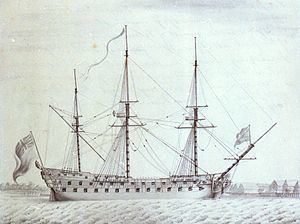
HMS Invincible sank in February 1758 when she hit a sandbank in the East Solent. The ship remained upright for 3 days after its grounding allowing the crew to safely escape. The wreck site was designated under the Protection of Wrecks Act on 30 September 1980. In 1996 Amer Ved grounded at the wrecksite, although it is not clear whether or not this resulted in damage to the remains. In 2013 the wreck was placed on English Heritage's list of ten most at risk heritage sites due to parts of the ship being exposed by changing seabed levels. In July 2016 it was announced that £2 million of the fines imposed for the Libor banking scandal would be used to fund an excavation of the wreck site.
